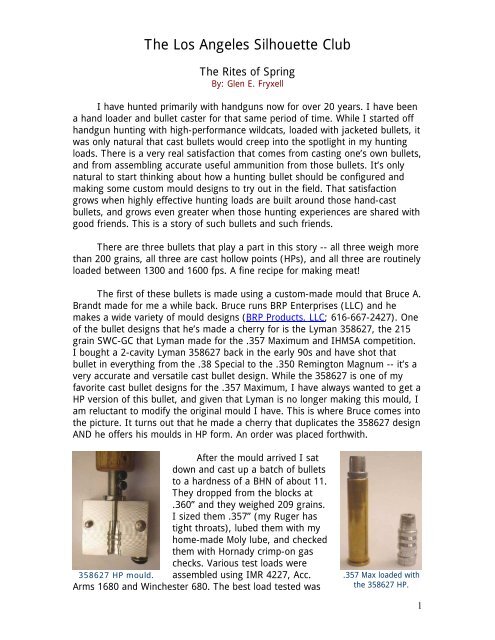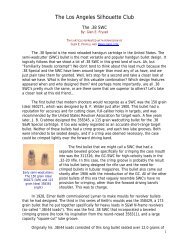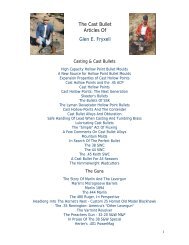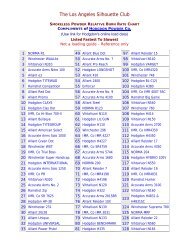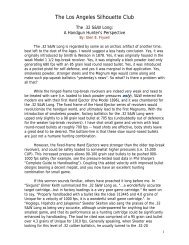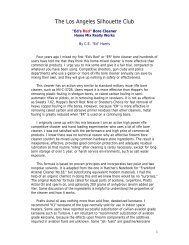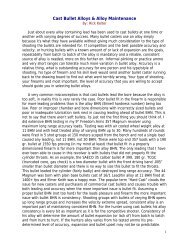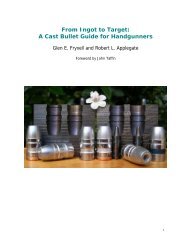Create successful ePaper yourself
Turn your PDF publications into a flip-book with our unique Google optimized e-Paper software.
The Los Angeles Silhouette Club<br />
The Rites of Spring<br />
By: Glen E. Fryxell<br />
I have hunted primarily with handguns now for over 20 years. I have been<br />
a hand loader and bullet caster for that same period of time. While I started off<br />
handgun hunting with high-performance wildcats, loaded with jacketed bullets, it<br />
was only natural that cast bullets would creep into the spotlight in my hunting<br />
loads. There is a very real satisfaction that comes from casting one’s own bullets,<br />
and from assembling accurate useful ammunition from those bullets. It’s only<br />
natural to start thinking about how a hunting bullet should be configured and<br />
making some custom mould designs to try out in the field. That satisfaction<br />
grows when highly effective hunting loads are built around those hand-cast<br />
bullets, and grows even greater when those hunting experiences are shared with<br />
good friends. This is a story of such bullets and such friends.<br />
There are three bullets that play a part in this story -- all three weigh more<br />
than 200 grains, all three are cast hollow points (HPs), and all three are routinely<br />
loaded between 1300 and 1600 fps. A fine recipe for making meat!<br />
The first of these bullets is made using a custom-made mould that Bruce A.<br />
Brandt made for me a while back. Bruce runs BRP Enterprises (LLC) and he<br />
makes a wide variety of mould designs (BRP Products, LLC; 616-667-2427). One<br />
of the bullet designs that he’s made a cherry for is the Lyman 358627, the 215<br />
grain SWC-GC that Lyman made for the .357 Maximum and IHMSA competition.<br />
I bought a 2-cavity Lyman 358627 back in the early 90s and have shot that<br />
bullet in everything from the .38 Special to the .350 Remington Magnum -- it’s a<br />
very accurate and versatile cast bullet design. While the 358627 is one of my<br />
favorite cast bullet designs for the .357 Maximum, I have always wanted to get a<br />
HP version of this bullet, and given that Lyman is no longer making this mould, I<br />
am reluctant to modify the original mould I have. This is where Bruce comes into<br />
the picture. It turns out that he made a cherry that duplicates the 358627 design<br />
AND he offers his moulds in HP form. An order was placed forthwith.<br />
358627 HP mould.<br />
After the mould arrived I sat<br />
down and cast up a batch of bullets<br />
to a hardness of a BHN of about 11.<br />
They dropped from the blocks at<br />
.360” and they weighed 209 grains.<br />
I sized them .357” (my Ruger has<br />
tight throats), lubed them with my<br />
home-made Moly lube, and checked<br />
them with Hornady crimp-on gas<br />
checks. Various test loads were<br />
assembled using IMR 4227, Acc. .357 Max loaded with<br />
Arms 1680 and Winchester 680. The best load tested was the 358627 HP.<br />
1
19.0 grains of 4227, which is very accurate and generates about 1500 fps from<br />
my 7 ½” Ruger.<br />
The second bullet in this story is a HP version of the Lyman 33889. Back in<br />
‘93 JD Jones helped me bring a wildcat cartridge to life. The .338 GEF is based<br />
on the .356 Winchester case necked down to .338 with the body taper and<br />
shoulder blown out. From a 12” Contender the .338 GEF can launch the 200<br />
grain Nosler Ballistic Tip at 2100 fps and the 250 grain Partition at 1900+ fps.<br />
I’ve used the .338 GEF to take mule deer, pronghorn antelope and feral hogs. It<br />
works. Quite nicely, in fact. Not surprisingly, I wanted to find a good cast HP<br />
mould to feed my pet wildcat with. Well, the answer was found in the form of a<br />
single-cavity Lyman 33889 mould that I found for cheap. I took a piece of ½”<br />
aluminum round stock and turned a mandrel to fit the mould cavity and clamped<br />
the mould blocks onto this mandrel and drilled the channel for the HP pin using<br />
the tailstock. I chose to make a .135” diameter pin that extended .500“ into the<br />
bullet’s nose, tapered at about 5 degrees, with a rounded tip. When cast to a<br />
BHN of about 12-13, these bullets drop from the blocks at .340” and weigh 240<br />
grains. I size them .340”, lube them with home-made Moly lube and check them<br />
using Hornady GCs. My favorite load for this bullet is 46.5 grains of H4831, which<br />
generates right at 1600 fps (See The 338 GEF Revisited). This is not a maximum<br />
load pressure-wise (nowhere near), but this is about as fast as I can go with the<br />
1 in 10” twist and maintain top shelf accuracy with this cast HP. This load is very<br />
accurate and 1600 fps is a very useful velocity for a cast HP. I have used this<br />
bullet to kill a feral hog and a mule deer and have complete confidence in it for<br />
medium game -- it expands well and exits.<br />
33889 HP and<br />
loaded .338 GEF<br />
The third bullet of this trilogy is based on the RCBS .44<br />
300 grain GC-SWC. A while back I sent this mould off to my<br />
good friend Erik Ohlen; Hollow Point Mold or email, (541)738-<br />
2479) with the instructions to convert it to a 2-cavity Cramer<br />
style HP mould (See In search of the perfect bullet), with a<br />
.150” diameter mouth, 7 degree taper, a cavity that extended<br />
.250” into the bullet. The mould showed up a short time later,<br />
modified exactly as requested. Let me tell you, the Cramer<br />
system let’s you cast a heap-big pile of HPs in a hurry! These<br />
bullets drop from the blocks at 297 grains. I size them .430”<br />
and load them over 21.0 grains of 296 in .44 Magnum cases<br />
for about 1350 fps (depending<br />
on barrel length). I used this<br />
bullet to kill a smaller hog last<br />
year, and it performed beautifully, but I wanted to<br />
try it on something a little larger this year. And it<br />
turns out that a very special 7 ½“ Ruger Old Model<br />
Super Blackhawk that I bought earlier this spring<br />
from my friend Mark just so happens to shoot this<br />
bullet to point of aim with the rear sight bottomed<br />
out. I love it when a plan comes together!<br />
RCBS 300 Gr. HP and loaded<br />
round<br />
2
Hunting season is a special time for me -- the angry clouds of autumn, the<br />
turbulent changing weather, the cold mornings and crisp sunrises, and the<br />
promise of seeing game when you least expect it. But I’m a Southern Boy at<br />
heart and historically Spring has been typically set aside for slower, more relaxed<br />
activities like fishing for catfish or bass. I don’t fish as much as a I used to (the<br />
word “pathological” comes to mind…), but I still like to get outdoors and stretch<br />
my legs a bit. Anymore, I like to get out and do a little light-hearted hunting.<br />
Since there are limited spring hunting seasons for game animals, this commonly<br />
means patronizing a fee hunting ranch. And since I’m a Southern Boy at heart,<br />
this commonly means hunting feral hogs (I love Carolina barbeque!). This spring<br />
I tried to coordinate hunting trips with a couple of my friends, but their<br />
schedules turned out to basically be incompatible, so I ended up scheduling two<br />
trips down to Clover Creek Ranch in central Oregon.<br />
For the first hunt, I would be hunting with my friend John. I had decided to<br />
take a Corsican ram. I’ve always admired the colors, the mask, and the beard of<br />
the Corsicans, and I was specifically looking for something with approximately<br />
full curl and an outward flair at the tips. Corsicans aren’t very big animals (~100<br />
lbs) and I figured the .357 Max, loaded with the 209 grain 358627 cast HP at<br />
1500 fps would be just the ticket. The scoped .338 GEF Contender, loaded with<br />
the 240 grains 33889 HP cast HP would serve as my back-up gun for this hunt.<br />
John wanted a meat hog and would be hunting with his .308 rifle, loaded with<br />
180 grain Partitions at about 2600 fps.<br />
We got down to the ranch late afternoon on Friday, and got settled into the<br />
Bunkhouse. Dinner that night was a very simple, and very tasty recipe of<br />
andouille sausage, potatoes, onions simmered in gewürztraminer with a healthy<br />
dash of red pepper. Sweet, hot sausage ‘n spuds. Man, that was good!<br />
The next morning I woke John (that sleep-head!) up with the coffee pot<br />
perkin’ and the smell of sausage (from last year’s hog) sizzling’ in the skillet. We<br />
added scrambled eggs and bread, and ate like kings at O-dark thirty (I love<br />
breakfast in hunting camp!). Well fed, we headed up the hill into the ranch.<br />
We got up on top, into the big pasture, and crossed the muddy drainage to<br />
check out the other side, when we looked back over our shoulders and saw a<br />
large group of mixed sheep and goats (Corsicans, black Hawaiians, Oregon Dahl,<br />
Catalina, Merino, etc.) 600 yards away, up amongst the junipers on the slope<br />
behind us. The binocs revealed several good Corsicans in the group. We drove<br />
back to the muddy drainage and parked the truck back behind some brush, and<br />
got out. John was seriously jazzed as he wanted to see one of these rams up<br />
close and personal. I strapped on the .357 Max, loaded with Bruce’s 358627 HP<br />
at about 1500 fps and tried to put together a fairly direct stalk up through the<br />
junipers. I was able to work my way up the hill up to about 150 yards or so from<br />
the group, but they started getting nervous and weren’t going to let me get any<br />
closer. Time for Plan B. We went back to the truck, and then ducked around<br />
behind the back of the hill and then tried going up the back of the hill around to<br />
swing around in front of the group and come over the top of the hill, to surprise<br />
3
them on top. The stalk went very well and we came out in the middle of a<br />
broken up rock outcropping near the crest of the hill. The group was about 125<br />
yards in front of us, milling about nervously on the slope in front of us. The stalk<br />
went well, the wind was in our favor, we hadn’t been “busted“, but the landscape<br />
was such that we couldn’t get any closer, so I chose to set up behind a<br />
rock outcrop and see if they might feed over in our direction. In fact, they did,<br />
but a couple members of the group caught a glimpse of me hiding behind the<br />
rocks and got real nervous. The group got all bunched up and started milling<br />
about nervously. I couldn’t get a clear shot, but I did see that there was a very<br />
good Corsican in the group that had the curl and outward flair I was looking for.<br />
The gun and the load were certainly up to taking a 100-lb Corsican at 125 yards,<br />
but it was still early morning, on a gray, overcast morning and I didn’t trust<br />
middle-aged eyes with iron sights to place the shot with the level of precision<br />
that I want, so I called off the stalk and John and I went back to the truck,<br />
laughing about Mother Nature’s sense of humor.<br />
Given the skittishness of this group of rams, I made an “executive decision”<br />
and decided to ditch the .357 Max and go with the scope-sighted .338 GEF<br />
Contender and the 33889 HP at 1600 fps. A group of yaks had fed up over the<br />
ridge that we had been using for cover for our previous stalk, and a whacky idea<br />
occurred to me. Maybe if we made it look like we were interested in the yaks,<br />
and paid no attention to the rams, we might be able to work up the hill and get<br />
within range for a shot at a nice Corsican. The yaks weren’t terribly “spooky” and<br />
we basically walked slowly up the hill directly towards them (ignoring the rams<br />
off to our right). The rams were still all bunched up. At one point there was a<br />
large patch of juniper between me and the rams and I did a smart right-face and<br />
marched right up to the junipers. Since most critters key on the upright human<br />
form, I laid down prone and belly-crawled around the left-hand side of junipers<br />
to a piece of greasewood that I had picked out to use as an impromptu field rest.<br />
At this point, the animals were bunched up, about 75-80 yards off. I quickly<br />
scanned the group to see which Corsican ram was what I was looking for. Across<br />
the front of the group there were three that were virtually indistinguishable (I<br />
couldn‘t help but think “Huey, Dewey and Louie“), and all had the traits I was<br />
looking for, but none of them presented a clear shot opportunity. I was not<br />
ready for what happened next. Suddenly the entire group started trotting<br />
towards me, quartering to my left. In the process one of the three I’d identified<br />
earlier broke out on the left side of the bunch and gave me a clear shot. I pulled<br />
the gun off the greasewood rest and rolled over into a roll-over prone position,<br />
swung the crosshairs onto his shoulder and snapped off a shot at about 40<br />
yards. The 240 grain 33889 cast HP hit the Corsican ram audibly, and he went<br />
down hard. As I got up I instinctively reloaded the Contender. As I did, I<br />
replayed the shot in my mine and realized that I had rushed the shot and hit him<br />
a little higher than I would have liked. He was down, and definitely not going<br />
anywhere, but he was still kicking and struggling when I got to him, so I put a<br />
second 33889 HP through his lungs and all was quiet quickly after that. He was<br />
beautiful, and exactly what I had been looking for. Later, inspection of the<br />
wound channel confirmed that the first shot had raked through the chest, from<br />
the left shoulder and exited just below the right kidney. It had traversed just<br />
4
elow the spine, rupturing the major blood vessels that travel along the spine.<br />
The spinal shock was what knocked him off his feet, and the hemorrhage would<br />
have ultimately killed him, but the second shot hastened things in a humane<br />
fashion. I was one very happy hunter, I had my Corsican.<br />
The fact that I had switched to a<br />
scoped Contender for a shot that ultimately<br />
could have been done easily with the ironsighted<br />
.357 Max revolver was not lost on<br />
John and me, and we laughed about the<br />
“Irony of the Hunt” on the way down the hill<br />
(it’s easy to laugh when there’s meat in the<br />
truck!).<br />
From previous visits we knew of a<br />
remote spot up in the woods that was a<br />
favorite bedding spot for some of the hogs on<br />
this ranch. John and I worked our way<br />
through the woods to a spot above this area<br />
Glen and the Corsican and slowly snuck into position where we<br />
could look over the dozen or so hogs that were bedded down there. John was<br />
looking for a good meat hog (about 300 lbs), and wanted to have the<br />
opportunity to look over several hogs and pick-n-choose what he was going to<br />
take (last year he basically took the first decent sized animal that gave him a<br />
good shot opportunity). Several of these hogs were considerably bigger than<br />
what he was looking for, and a couple of them were smaller, but there were 2 or<br />
3 that would fit what he was looking for. One was bedded down front and<br />
center, with a dirt birm shielding his vitals, and the other two were farther back<br />
in the groups and milling about behind the bigger hogs and some brush. We<br />
were about 50 yards above the hogs and decided to try to move in a little closer.<br />
At about 35-40 yards we got busted, and several of hogs started to get up and<br />
stare in their squinty-eyed way at us to try and figure out what we were. It was<br />
about this point that the sleeping hog in front of us decided to wake up and<br />
stretch his legs. As he stood, John saw to it that he never regained his feet. The<br />
180 grain Partition (44.0 grains of Winchester 748, 2600 fps) hit him behind the<br />
left shoulder, and he went down hard, squealing. Most of the hogs moved out,<br />
but one of them moved in and started slurpin’ up the blood from his dying<br />
brother (that’s hogs for you…). John’s hog died quickly, and we shooed the other<br />
hog off and got a few pictures. The 180 Partition had entered in the middle of<br />
the left side ribcage and exited a little farther back on the right side, taking both<br />
lungs and liver in its travels. There was basically a 1” core removed from this<br />
hog, from one side to the other -- he bled freely and died quickly. Clark came in<br />
with his 4-wheeler and picked the hog up and got it down to the skinning shed<br />
for us. John was very pleased with his hog and got lots of prime pork off of it.<br />
Before we left to hunt that afternoon, I had browned a pound of stew beef,<br />
added a can of black beans, a can of whole kernel corn, some diced onions and a<br />
dash of red pepper, and threw the whole mess into a crock pot, so when we<br />
5
came back from hunting there was a crock pot<br />
full of some un-named mystery goulash<br />
waiting for us. It was wonderful! There were<br />
no leftovers…<br />
John and his hog.<br />
The next morning we boned out meat<br />
and packed it into coolers for the drive home.<br />
Later that week, we made some Italian<br />
sausage out of part of John’s hog and it tuned<br />
out really well. I was having a hard time<br />
making up my mind what I was going to go<br />
after on the second half of my spring hunt,<br />
and that Italian sausage did it for me -- a hog’s<br />
fate was sealed!<br />
Two weeks later, I met Bob down at Clover Creek on Sunday afternoon.<br />
Bob wanted to shoot a yak, specifically a cow yak (there was only one left and it<br />
was “on sale”). I would be looking for a meat hog in the 200-300 lb range. Bob<br />
would be hunting with his Ruger 77 .30-’06, loaded with 180 grain Nosler<br />
Partitions over a healthy charge of 4350 for about 2700 fps, and I would be<br />
hunting with the Old Model Ruger Super Blackhawk (that I had just bought from<br />
my friend Mark earlier this spring), loaded with the 300 grain cast HP that I had<br />
my good friend Erik Ohlen modify for me a little over a year ago. It would be<br />
loaded over 21.0 grains of Winchester 296 for about 1350 fps.<br />
First night’s dinner was Italian sausage (from John’s hog, taken 2 weeks<br />
earlier) in sweet basil marinara sauce over tri-color rotini pasta served with salad<br />
and a bottle of old vine zinfandel. Yeah, we were really roughin’ it! We built a<br />
campfire in the new fire-pit that Clark had built and then sat back and told<br />
hunting stories and listened for the coyotes.<br />
I woke up at 5:30 the next morning, turned on the coffee pot and started a<br />
some breakfast sausage on the hot plate (I like sausage and eggs). It seems<br />
some old retired folks are kinda grumpy when their morning routines get<br />
changed. Soon the bunkhouse was full of the smells of sizzling sausage and<br />
fresh-brewed coffee, providing motivation for Bob to drag his carcass out of bed.<br />
After breakfast was polished off, we headed up the hill, and into the ranch. We<br />
didn’t see any yaks at any of the places where John and I had seen them 2<br />
weeks before (Clark had told us that there had been some hunting pressure on<br />
the yaks recently and their skittish behavior seemed to bear that out). We moved<br />
all over the ranch looking to see where the yaks had moved to and all we saw<br />
were 4 big bulls in the big pasture on top (Bob wanted a cow), so we swung<br />
down to the big catch basin at the bottom of a big bowl, to look around for the<br />
hogs, to see if I could find one in the size range I was looking for. As we worked<br />
our way up the drainage, we found one blonde sow, fast asleep, bedded down in<br />
the middle of a sandy wash, in a sunbeam. She went 325-350 lbs, and was a<br />
little bit bigger than what I was looking for, so we left her sleeping and came<br />
back down to camp for lunch.<br />
6
Bob was the lunch chef, and fixed venison burgers made from one of the<br />
coastal blacktail bucks he’d shot over on the Olympic Peninsula. That was some<br />
of the best venison that I have ever tasted! As we washed the burgers down<br />
with a cold soda, Clark told us that he thought the yaks might be holed up out of<br />
the wind (which was really picking up), hiding in some woods on the leeward<br />
side of a ridge that abutted the big pasture on top. We made a mental note to<br />
swing by those woods and do a little bird-doggin’. We also decided to go and see<br />
some other parts of the ranch that we hadn’t been to on this trip yet. After<br />
lunch, we headed out and went up the rocky road that goes immediately behind<br />
the ranch house.. We started seeing rams almost immediately -- Corsicans,<br />
Oregon Dahls, Merinos, 4-horns, etc. Then there were a couple of big Texas<br />
longhorns, and a shaggy old buffalo bull. This was a relatively sheltered part of<br />
the ranch, and the winds were really picking up (the forecast was for 60+ mph<br />
winds that afternoon), and the critters were coming down here to get out of the<br />
wind. But no yaks, and no hogs. We kept moving.<br />
Eventually, we broke out on the “main road” up near the top. It was really<br />
blowin’ now and we decided to follow up on Clark’s suggestion of working the<br />
backside of the ridge. I started up the 4-wheeler track, intent on getting Bob<br />
established on the right set of tracks, and then dropping back and letting him<br />
take the lead, in case we jumped anything. I was no more than 30-40 yards into<br />
the woods when I kicked up a big yak bull. Man, did I ever feel stupid! Bob got<br />
out in front and followed that big shaggy black bull up the hillside (and I hung<br />
back at the truck so as not to interfere with any more of Bob’s stalks). He came<br />
back saying that the bull was heading in the direction of the big pasture and that<br />
he thought there might be some other yaks up there, so we loaded up in the<br />
truck and headed up the hill.<br />
As we approached the big pasture, Bob looked over where he expected to<br />
see the yaks, and said, “Yup, there’s the 4 big bulls we saw this morning.” Wait a<br />
minute, these animals were all different sizes, and the 4 bulls were all the same<br />
size. Bob put the binocs on them and sure enough, this group was composed of<br />
a bull, a cow, a yearling and a calf (the calf “belonged” to a different cow that<br />
had already been taken, after the calf had been weaned; there was only one cow<br />
left and at 3 ½ years old she had never dropped a calf and was “dry“). “Glen, I<br />
believe we’ve found my cow.” Now we just needed to figure out how to close the<br />
half mile between us.<br />
A direct stalk was out of the question. We would be in plain sight the entire<br />
way, and we already knew that these animals were skittish. There was a slight<br />
rise above them, and if we continued up the road we were on to the big pasture<br />
on top, that rise should shield us until we got on the other side of the pasture.<br />
We could then work down a line of trees on that side and get into position for a<br />
shot. We were off.<br />
The 4 big bulls were up by the a stand of trees on the fence line, using that<br />
as a wind break. We slowly drove past them at a comfortable distance so as not<br />
to spook them. We got up to the tree line and parked the truck out of the way<br />
7
(but in the direct line of the wind as it came over the saddle, it was blowing at<br />
40+ mph out of the west at this point). The group of 4 bulls was out about 250-<br />
300 yards to the south of us, and the group of 4 yaks were a couple hundred<br />
yards east of us, moving into the wind to ultimately join up with the 4 bulls. The<br />
original plan had been for Bob to sneak down the edge of the tree line about 150<br />
yards to get in position above his cow, and to shoot from there. With them<br />
moving (and covering ground at a deceptive pace), that was no longer an option.<br />
I hid in the bushes at the top of the hill, and Bob was able to sneak down to a<br />
shielded position about 50-60 yards to my left and set up on the edge of the tree<br />
line and let the yaks move into his field of fire. They were about 125 yards in<br />
front of us, moving at a steady walk from our left to right, and the wind was<br />
blowing 40+ mph from our right to left. Bob was shooting slightly downhill, from<br />
an open-legged sitting position, at a moving target, with a 40+ mph crosswind<br />
blowing straight out of 3 o’clock. Not the best of conditions to shoot in, but Bob<br />
managed to shoot well in spite of the conditions. His first shot hit the cow yak<br />
hard and stopped her in her tracks, with her head sagging. The other 3 yaks pick<br />
up their pace and started to trot off towards the 4 bulls. Bob quickly racked the<br />
bolt on his ‘06 and put a second 180 grain Partition into the cow and she went<br />
down hard. Both bullets slammed home loudly from my vantage point off to<br />
Bob’s side.<br />
With the second shot, the 4 bulls started trotting over to meet the younger<br />
bull, yearling and calf that were coming their way. As the two groups merged,<br />
they headed back over to the dead cow and started nudging her and kicking her<br />
to get her to get up and leave, warning her that there was danger in the area.<br />
When she didn’t respond, they got more and more intense, eventually to the<br />
point of hooking her with their horns and trying to flip her over! This went on for<br />
a full 5 minutes with Bob and me watching from the top of the pasture. They<br />
didn’t actually leave the dead cow until we got in the truck and drove down there<br />
and honked the horn repeatedly at them. They were none too happy about<br />
losing “the last girl at the dance”!<br />
Later we learned that Bob’s first shot had landed a little farther back than<br />
he had intended due to the severe crosswind, but still caught part of the liver<br />
(which is what slowed her down). His second<br />
shot center-punched her volleyball-sized heart<br />
and literally blew the backside of it off. The<br />
elapsed time between the first and second<br />
shots was no more than 3 or 4 seconds. Nice<br />
shooting!<br />
Clark came up with his 4-wheeler and<br />
trailer to haul the yak down to the skinning<br />
Bob and his 400 lb yak. Bob took the shed, and Bob and I moved off in search of<br />
shot from the line of trees behind hogs. So far, the only hog we had seen was<br />
him.<br />
the one big blonde sow, so we moved back<br />
down to the shelter of the catch basin at the bottom of the big bowl to see if<br />
8
there were any other hogs that had moved down to the shelter of those<br />
protected woods. We knew as soon as we parked the truck and started up the<br />
drainage that there were hogs in the area as we could hear an occasional grunt<br />
here and there. I was working into the wind, but that would put me directly<br />
downhill from their bedding spot, a poor position to evaluate size and shot<br />
placement. So I swung out parallel to the left so I could get alongside them<br />
without giving them my scent, and then I would “play it by ear” after I figured<br />
out what I was looking at. From the other side of the drainage, about 50 yards<br />
away, I could make out two large sows bedded down -- one dark brown and<br />
spotted, and the other a “dirty blonde”. Both were in the 450 lb range, and much<br />
larger than what I was looking for. Off in some brush a little farther beyond<br />
those two were another 6 or 7 hogs bedded down, including the blonde sow I<br />
had seen earlier in the day, along with a few more of similar size, as well as a<br />
couple that were smaller (one I guessed at about 150 lbs and one at about 250<br />
lbs). This group was bedded down all bunched together, and there was no way<br />
that I could get a clear shot at any of them.<br />
The hogs were directly in front of me, with the wind coming straight out of<br />
9 o’clock. I decided to cross the drainage to my left and put myself directly<br />
upwind of the two sows (but not the rest of the herd) and see if I could spook<br />
them “gently”, get them up on their feet, and then get a clear shot at that 250-<br />
pounder. The plan worked like a champ -- I quietly snuck across the drainage<br />
and as soon as I got up on the other side (directly shielded by several juniper<br />
trees so the two sows couldn’t see me), my scent wafted down to the sows and<br />
they sprang to their feet, using their beady little pig eyes to try to find the threat.<br />
The other hogs were off to my left, out in the open, but still crosswind to me.<br />
They didn’t see or hear me, but noticed that the two big sows were rattled, and<br />
so they started to stir and stand. When the hog I’d picked out stood up, he was<br />
quartering towards me (facing my right) and I had a clear 40 yard shot. I<br />
brought the OM SBH up, drew a bead just behind the right shoulder, and fired.<br />
The hog started squealing and jumping around in circles, doing pirouettes like a<br />
rodeo bronc. I’ve seen cases where mortally wounded animals have reacted this<br />
way, so my first reaction was that he was probably going down quickly. Such<br />
was not to be. After a few seconds, the herd gathered up and started moving<br />
off, up the drainage to my left. The wounded pig fell in with them and started<br />
trotting off with them, leaving a strong blood trail from his bloody left<br />
hindquarter (when I saw that, I thought that was odd as I would have expected<br />
my shot to exit at the back of the left-side ribs, but bullets sometimes turn inside<br />
an animal so I didn’t think too much about it). I ran to catch up with the herd,<br />
and got within about 15 yards of them, but they stayed all bunched up in the<br />
bottom of the creek channel, offering no clear shot. Suddenly, the wounded hog<br />
took off up the opposite creek bank, putting himself in the clear, only about 15<br />
yards away. The Ruger .44 Mag came up and I drew a bead on his left shoulder<br />
and fired. Right as the hammer fell, the hog jumped uphill to gain more elevation<br />
on his climb, and I called that shot as a clean miss (low). However, the shot had<br />
an immediate effect of turning him 180 degrees and motivating him to now run,<br />
instead of trot, downhill and away from danger (I figured I must have sprayed<br />
rocks and gravel on him with the shot). I ran down the creek channel on the<br />
9
opposite bank. Now separated from the rest of the herd getting a clear shot was<br />
easy, and I put a 300 grain HP right through the middle of his ribs, flattening him<br />
instantly. He collapsed and tumbled down into the bottom of the creek, wedging<br />
himself in between two large rocks. With him down at the bottom of that creek,<br />
it soon became apparent that my original estimate of “about 250 pounds” was<br />
off by a bit, and this guy was more like 300 lbs. Clark came in with his 4-<br />
wheeler, and it took the three of us 30-40 minutes to get that hog out of that<br />
creek channel, and loaded up onto his trailer. I shudder to think what that job<br />
would have been like without Clark’s 4-wheeler and trailer.<br />
Back at the skinning shed we were able to piece together what had<br />
happened with my hog. Plain and simple, I jerked the trigger on that first shot,<br />
and pulled it low and a little left. It had gone in below the ribs and just creased<br />
the belly, then hit the far side (left) hindquarter, where just by pure luck it had<br />
hit the femoral artery (hence the strong blood trail). This wound would have<br />
eventually proven fatal, but only by random luck. The second shot had indeed<br />
gone low (just as I had called), but it had hit a rock and ricocheted straight up<br />
vertically into the left “armpit” of the boar, and traveled up in between the<br />
shoulder muscles and the ribs, doing substantial damage to a lot of meat in the<br />
ribs, but not doing much that would hasten porky’s demise. The third shot<br />
entered the center of the right side ribcage and exited in the rear portion of the<br />
ribs on the left side. The 300 grain cast HP expanded well, did extensive damage<br />
to both lungs and punched right on out the other side.<br />
Clark had most of the skinning<br />
chores done before we got back down to<br />
camp (he’s fast with a knife!). It got down<br />
below freezing that night, so both the yak<br />
and the hog chilled down quite nicely.<br />
Dinner that night was pan-fried steaks<br />
(much too windy to grill over the campfire<br />
like we had planned) and salad. Sleep<br />
came easily for me that night.<br />
Old Model SBH<br />
After a hearty breakfast the next morning we got Bob loaded up and on the<br />
road, and then I sat down and butchered my hog for the trip back home. On this<br />
trip I was using a Dozier Professional Skinner that I had just bought from a<br />
friend of mine down in Texas. For many years I have heard of the reputation of<br />
Bob Dozier’s knives and the exceptional edge retention resulting from his heat<br />
treatment of D2 steel to 60-61 Rc. I’ve always wanted to work with one, but had<br />
just never “pulled the trigger” and bought one. Well, Mark offered one up for<br />
sale earlier this spring, and it was even the model that I favored, so I just<br />
decided that the time had come, and mailed him the check. The Dozier<br />
Professional Skinner performed beautifully while I was butchering this hog. I<br />
never once had to touch up the edge, and it still shaves after cutting all that<br />
pork. This is a magnificent knife!<br />
OK, there is one thing that I’m not real crazy about, and that’s the Kydex<br />
10
sheath. I must confess to being something<br />
of a traditionalist and preferring a simple<br />
leather scabbard for my hunting knives, and<br />
Kydex tends to make me think “tactical<br />
wannabee“. I understand the functional<br />
appeal of Kydex, it’s just that it lacks the<br />
beauty and class of a fine leather sheath.<br />
This particular knife is housed in Dozier’s<br />
Vertical Kydex sheath (the default sheath<br />
Dovier Professional Skinner and sheath for this knife is the Horizontal Kydex<br />
sheath). I have to say that this sheath has<br />
all the esthetics of a rusty bumper-jack that’s been rattling around underneath<br />
the seat of an old 1967 Ford work truck. But like that bumper jack, it does its<br />
job, and does it well. After wearing this knife (and sheath) for 2 days hunting, I<br />
can honestly say that it’s the best functional sheath I’ve ever used -- the<br />
counter-radiused belt loop holds the sheath (and knife) up snug to the body (I<br />
don‘t like “floppy“ sheaths), it provides rapid and positive access to the knife,<br />
and it provides excellent protection from the razor sharp D2 blade. In short, it<br />
works, and extremely well. I guess I can learn to live with its homely looks<br />
(besides it’s on the backside of my belt, so I don’t have to look at it when I’m<br />
hunting!).<br />
All in all, it was a great spring -- I got in some interesting hunts with good<br />
friends, and I got a chance to hunt with some excellent cast bullets. We ate well<br />
and took some very nice animals. Unfortunately I didn’t get a chance to put the<br />
358627 HP in the .357 Max to work, but maybe next spring….maybe a black<br />
Hawaiian ram…<br />
- Glen E. Fryxell<br />
Warning: All technical data mentioned, especially handloading and bullet casting,<br />
reflect the limited experience of individuals using specific tools, products, equipment and<br />
components under specific conditions and circumstances not necessarily reported in the<br />
article or on this web site and over which The Los Angeles Silhouette Club (<strong>LASC</strong>), this<br />
web site or the author has no control. The above has no control over the condition of<br />
your firearms or your methods, components, tools, techniques or circumstances and<br />
disclaims all and any responsibility for any person using any data mentioned. Always<br />
consult recognized reloading manuals.<br />
The <strong>LASC</strong> <strong>Front</strong> <strong>Page</strong><br />
Index to all <strong>LASC</strong> Articles<br />
Glen E. Fryxell Article Index<br />
11


